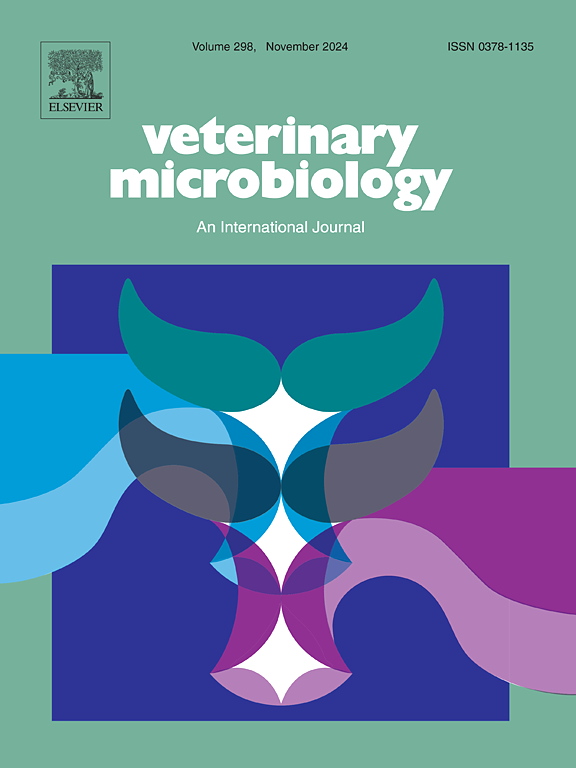为增强噬菌体治疗犬外耳炎量身定制配方:针对铜绿假单胞菌和假中间葡萄球菌的鸡尾酒疗法。
IF 2.7
2区 农林科学
Q3 MICROBIOLOGY
引用次数: 0
摘要
犬外耳炎的特点是涉及多种细菌,特别是铜绿假单胞菌和假中间葡萄球菌,需要抗生素治疗作为主要治疗方法;然而,长期治疗往往导致抗生素耐药性。因此,噬菌体作为抗菌药物的应用已成为近年来研究的热点。然而,噬菌体疗法有局限性;它的功效取决于噬菌体的裂解能力和噬菌体耐药性的出现,而噬菌体耐药性可以通过使用噬菌体鸡尾酒来克服。本研究旨在通过补充额外的材料来阻碍病原体,并结合不同的病毒来扩大噬菌体的裂解谱,从而增强噬菌体的治疗潜力。由假单胞菌噬菌体pPa_SNUABM_DT01和葡萄球菌噬菌体pSp_SNUABM-J组成的噬菌体鸡尾酒,通过体外浮游细菌细胞裂解实验和生物膜降解实验来评估其治疗潜力。此外,通过小鼠体内外耳炎模型和5只慢性铜绿假单胞菌和假中间葡萄球菌外耳炎犬的临床给药来评估其疗效。含有甘油、甘氨酸和Tween 20等制剂的噬菌体鸡尾酒可显著减少细菌数量,改善临床症状,包括气味、分泌物类型和数量以及炎症症状。结果表明,使用含有额外成分的噬菌体鸡尾酒溶液可以使噬菌体疗法更有效地治疗犬外耳炎。这为传统的抗生素治疗提供了一种实用的替代方法,并有助于减轻兽医中的抗生素耐药性。本文章由计算机程序翻译,如有差异,请以英文原文为准。
Tailoring formulation for enhanced phage therapy in canine otitis externa: a cocktail approach targeting Pseudomonas aeruginosa and Staphylococcus pseudintermedius
Canine otitis externa, characterized by the involvement of diverse bacterial species, notably Pseudomonas aeruginosa and Staphylococcus pseudintermedius, necessitates antibiotic administration as the primary therapeutic approach; however, prolonged treatment often precipitates antibiotic resistance. Therefore, the application of bacteriophages as antimicrobial agents has been of interest recently. However, phage therapy has limitations; its efficacy depends on the lytic capacity of the phage and the emergence of phage resistance, which can be overcome by using phage cocktails. This study aimed to enhance the therapeutic potential of bacteriophages by supplementing additional materials to hinder the pathogens and combining different viruses to broaden the lytic spectrum. The therapeutic potential of the phage cocktail, consisting of Pseudomonas phage pPa_SNUABM_DT01 and Staphylococcus phage pSp_SNUABM-J, was evaluated using an in vitro planktonic bacterial cell lysis assay and a biofilm degradation assay. Additionally, its efficacy was assessed using an in vivo mouse otitis externa model and clinical administration in five dogs with chronic Pseudomonas aeruginosa and Staphylococcus pseudintermedius otitis externa. The phage cocktail with formulation, including glycerol, glycine, and Tween 20, as additional components resulted in a significant reduction in bacterial counts and clinical improvements, including odor, discharge type and amount, and inflammatory symptoms. The results suggest that administering a phage cocktail solution with additional components could make phage therapy a more efficient treatment for otitis externa in dogs. This offers a practical alternative to traditional antibiotic treatments and could help mitigate antibiotic resistance in veterinary medicine.
求助全文
通过发布文献求助,成功后即可免费获取论文全文。
去求助
来源期刊

Veterinary microbiology
农林科学-兽医学
CiteScore
5.90
自引率
6.10%
发文量
221
审稿时长
52 days
期刊介绍:
Veterinary Microbiology is concerned with microbial (bacterial, fungal, viral) diseases of domesticated vertebrate animals (livestock, companion animals, fur-bearing animals, game, poultry, fish) that supply food, other useful products or companionship. In addition, Microbial diseases of wild animals living in captivity, or as members of the feral fauna will also be considered if the infections are of interest because of their interrelation with humans (zoonoses) and/or domestic animals. Studies of antimicrobial resistance are also included, provided that the results represent a substantial advance in knowledge. Authors are strongly encouraged to read - prior to submission - the Editorials (''Scope or cope'' and ''Scope or cope II'') published previously in the journal. The Editors reserve the right to suggest submission to another journal for those papers which they feel would be more appropriate for consideration by that journal.
Original research papers of high quality and novelty on aspects of control, host response, molecular biology, pathogenesis, prevention, and treatment of microbial diseases of animals are published. Papers dealing primarily with immunology, epidemiology, molecular biology and antiviral or microbial agents will only be considered if they demonstrate a clear impact on a disease. Papers focusing solely on diagnostic techniques (such as another PCR protocol or ELISA) will not be published - focus should be on a microorganism and not on a particular technique. Papers only reporting microbial sequences, transcriptomics data, or proteomics data will not be considered unless the results represent a substantial advance in knowledge.
Drug trial papers will be considered if they have general application or significance. Papers on the identification of microorganisms will also be considered, but detailed taxonomic studies do not fall within the scope of the journal. Case reports will not be published, unless they have general application or contain novel aspects. Papers of geographically limited interest, which repeat what had been established elsewhere will not be considered. The readership of the journal is global.
 求助内容:
求助内容: 应助结果提醒方式:
应助结果提醒方式:


